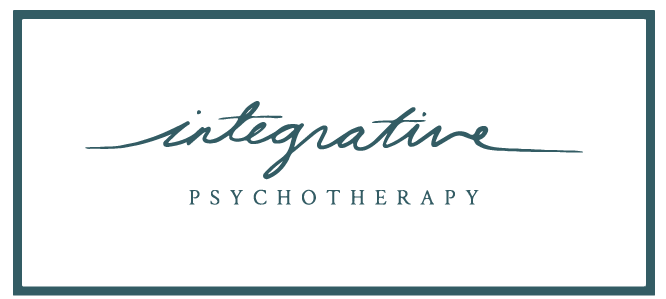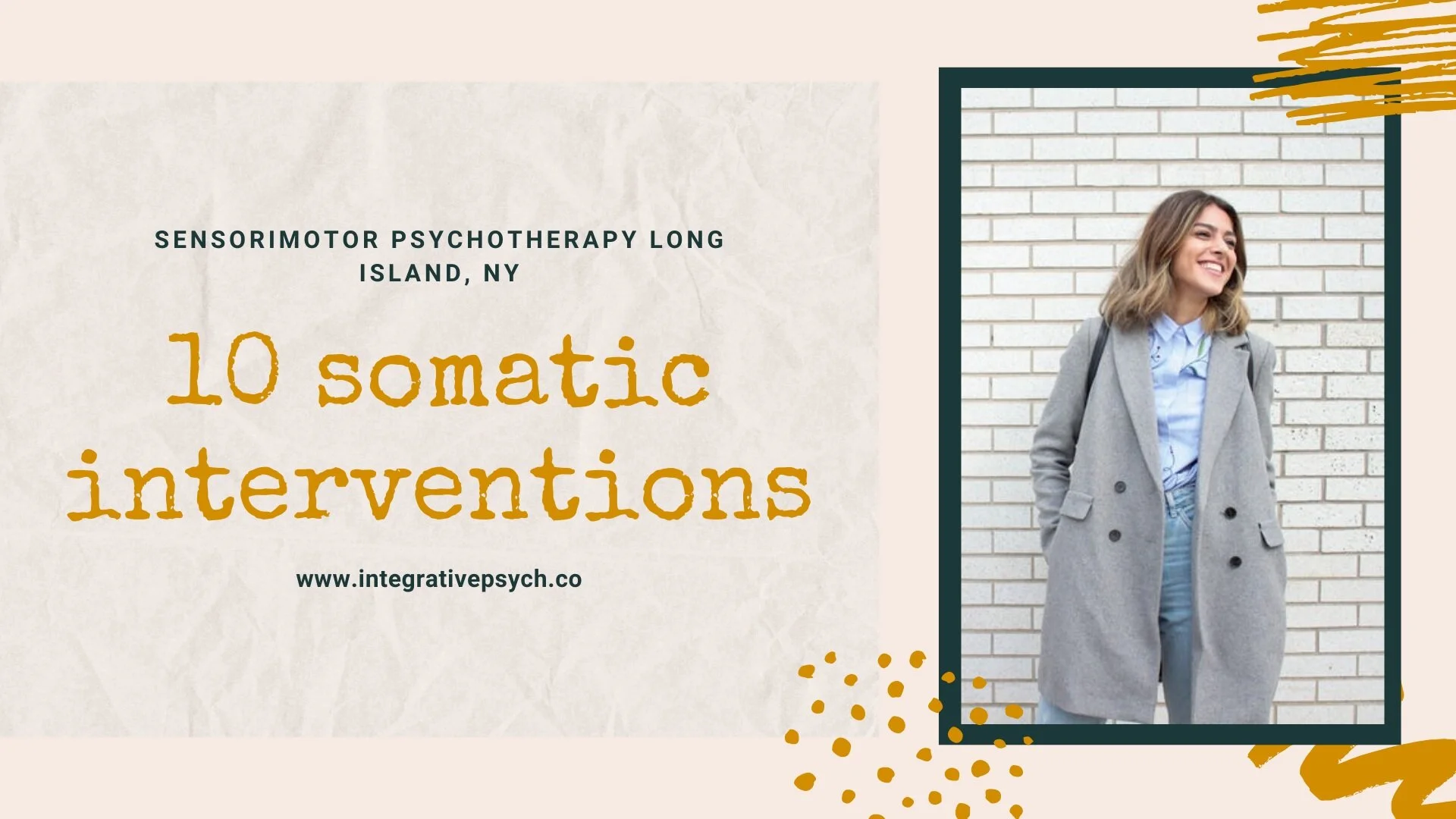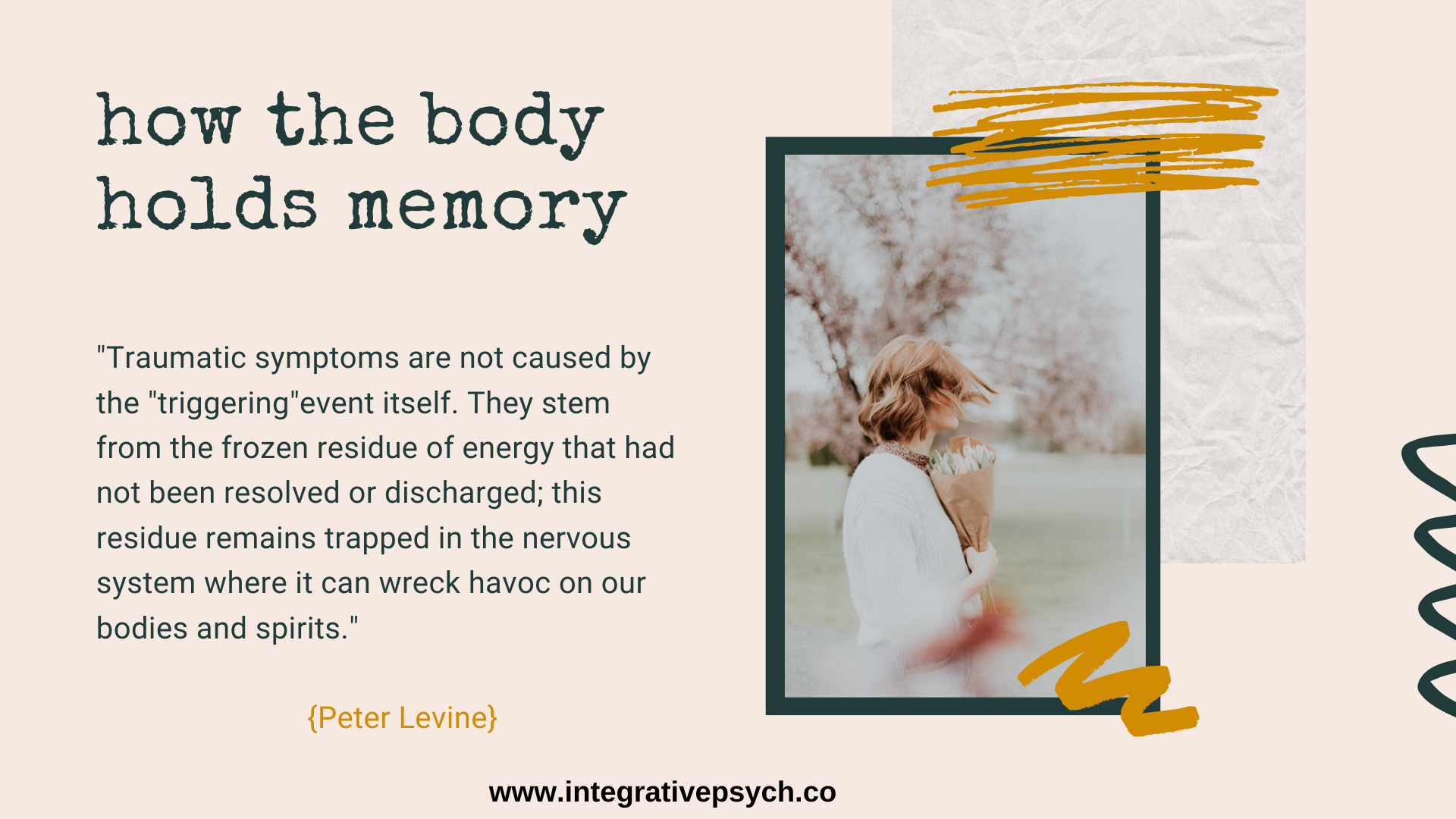10 Somatic Interventions Explained
As a somatic therapist who helps clients heal in mind, body and spirit, I often get asked about this method of treatment.
What is somatic psychotherapy?
Somatic Psychotherapy is a term that’s been used more frequently over the past few years as scientific research has proven that, as humans, we store memories, experience and emotions on a cellular level. Which means, it’s not “all in your head”; rather, our bodies hold data as well.
This is why many people express a feelings of “body anxiety” even in the absence of anxious “thoughts”. It’s also why you may find yourself not feeling very safe in your own skin on certain occasions, times of year or in certain environments, even if there is no “apparent” reason. Often, your body is reminded of something {even when your mind does not} and is sending an alert, a pause, or even a danger signal.
A body based therapy to help you heal on a cellular level
Initially, somatic therapies were created to help trauma survivors finally experience relief from their trauma symptoms such as flashbacks, difficulty sleeping, dysregulated eating patterns and chaotic relationships and lifestyles.
However, over the last number of years, somatic therapy has been effective in helping individuals who struggle with all kinds of stressors and has been effective in helping them finally experience relief.
Areas such as : relationship, intimacy, those seeking a feeling of security, wanting to feel trust, over/under achievers, parenting skills, managing anxiety, working though depression and other emotional difficulties.
Accessing the Root of the Issue- an Integrative Approach to Healing
Therapies which focus on talking about “tough stuff”, learning skills or solely rely on the psychodynamic relationship without somatic , mind-body awareness or trauma interventions can be helpful up until a certain point.
Sometimes, clients are “doing” all the right things, but somehow aren’t feeling relief. This often happens when the therapy emphasizes focuses on “brain-based issues”, often assuming the mind and thinking style to be causing psychological distress. However, many times, it isn’t “just in your head”, and it’s not always related to an anxious, depressive or nervous wracking thought that is the cause of the problem.
When your distress is carved on your body; not in your mind.
In certain instances, the brain and body have been wired {based on experiences], leaving the body with unconscious, deeply-rooted beliefs that are not accessible by cognitive approaches such as “I am bad” , “I’m alone”, or “I won’t ever heal”, many times, the person may not even be aware of the beliefs they carry until confronted with a struggle related to it.
Because of this, Dr. Peter Levine (founder of Somatic Experience) and Dr. Pat Ogden (founder of Sensorimotor Psychotherapy) have researched, introduced, and trained many therapists in somatic approaches, utilizing an integrative whole-body approach to psychotherapy, to help clients access the body-based beliefs and release experiences that have been held on the body. These approaches have helped clients experience long term relief.
Somatic psychotherapy is a therapeutic approach which engages the body awareness as a powerful tool and intervention in therapy.
Somatic approaches are used to engage the relationship between mind, body, brain, and behavior. Somatically trained therapists use interventions to help calm their clients’ nervous system, and create more ease in the healing process.
Curious to know more? Here are some key concepts used in somatic psychotherapy.
10 Somatic Interventions
1} Developing Somatic Awareness
In somatic therapy, we educate clients about what body awareness is, and how to cultivate body awareness in and around your body. This is a prerequisite to creating change on a cellular level. We begin by identifying areas of tension and areas of constriction, as well as thoughts, feelings and behaviors that promote a feeling of calm and safety, and bring these to conscious awareness. We may practice something small such as softening a “hunched” back to a more straightened posture, to begin working towards body alignment.
By focusing on, and amplifying the sensations in your body, you begin to deepen your healing experience and allow for change that you can “feel” in your skin.
2} Resourcing
Resourcing refers to the way we strengthen our sense of stability and safety in the world. In session, before beginning deeper work, we identify the resources you may have. Often we will look at significant people, relationships, ego strengths, experiences, times and places that strengthen a sense of safety and choice. Sometimes, this is a practice of coming up with a “secure space” - which can be real or imaginary, where we expand on a space that give you a feeling of peace, ease and calm.
We also resource “protective figures”, “wise figures”, and “nurturing figures” by bringing to mind individuals who give you a sense of strength, empowerment and trust- and from there we may ask your body; for example: “ how does it feel to be in your skin when you bring up the image of those people who are protective figures in your life?”
We “download” the sensations, thoughts and feelings associated with feel-good experiences so the mind + body can come back to these resource states later when trauma or anxiety work gets tiring. The resourcing provides as an anchor to replenish energies.
3} Grounding in the Here-And-Now
Grounding refers to our ability to experience our full selves as connected and “embodied”.
The concept of grounding is at the root of mind-body focused interventions. Alexander Lowen, developer of bioenergetics, introduced grounding as a concept in which we can live life, fully experiencing ourselves- connected in the world around us. We use grounding tools to help calm and regulate our nervous systems when we are feeling overly activated or triggered, as grounding helps sooth and settle.
Often I use a 4 Elements Exercise where we get in touch with the elements around us; earth, air, water and fire.
4} Using Descriptive Language
Today’s somatic focused therapy approach is all about getting curious, getting descriptive and staying close to the experience that’s happening in and around your body. Tension, anxiety and trauma memories get processed as long as you can track, contact, describe and allow the experience to move through you.
For example, you’re angry at something that’s happened, but you don’t want to stay angry and irritated. You can get descriptive to meet your body experience, to help yourself move through it.
You may begin with some words such as, “It feels like a raging fiery feeling welling up in my chest….”. As you stay with the sensations, and follow what happens next, you’ll notice the anger moves, and how it slowly shifts as you focus on the descriptive body sensation instead of the details of the upsetting event. You can use descriptive language as a method to deepen whatever you’re experiencing. Some descriptive words are: warmth, cold, tingly, sharp sensation, numb, dull pressure, ease, spinning, lifting, swirling, or calming.
5} Movement
Movement is a natural way for the body to move through difficult experiences, insecurities, past traumas and and intense emotions. Movement is a natural way to help strengthen your abilities to show up, be connected to others and feel more confident.
Movement helps us tap into our innate ability to heal the stories that our bodies hold.
If you take some time, you’ll notice how each of us carries stories and beliefs which impact how we interact with others and the people around us. Our gestures, postures, voice volume and presence in the room communicates what we believe about ourselves, what we expect, or what we’ve experienced in the past.
In session, we would use movement to help you move through something that is coming up. For example, if you have an urge to hide behind other people, or to speak really quietly, we would notice that urge, and stay with it, allowing you to take on a physical movement to represent “the need to hide”. You might crouch down or look away. As you do that, you may have a thought such that is related to this urge, such as “its not safe to talk, or I won’t be heard” or “I actually have something important to say”. You may also have an image come up that is matched with when you learned you needed to “hide”. All of this is data that is easier to access, process and release when combined with movement.
6} Co-Regulation & Self Regulation
Co-regulation refers to the way we calm ourselves down when we are connecting to someone else. In attachment focused therapies, the therapist uses her/himself to use mirror neurons to help the stressed or disconnected client calm down. When we are connect to another person’s sense of warmth, care and stability, we are able to better regulate our emotions.
Self Regulation is when we develop our own tools to calm ourselves down on our own. We all need a combination of both; soothing we get from others as well as our own abilities to self regulate when needed. Self regulation tools are taught to help you move through big emotions, and co-regulation techniques are used as well, in the therapy room, as well as teaching you how to utilize close relationships to help you regulate.
Emotional Regulation is also a vital ingredient in parenting because we teach our children how to regulate by how we help them regulate, and in turn, they learn how to self-regulate based on the co-regulation they got from the parent-child bond. Living a regulated life is one of the biggest accomplishments, because when we are regulated we are able to live more deeply, love more fully and experience the sweetness of daily pleasures.
7} Titration & Pendulation
Trauma, panic, fear, terror, anger, frustration and depression all express via sensations in the body. We can feel overheated, trapped, frozen, disconnected or completely lost. Those kinds of experiences and emotions won’t move when you dive into them head-first, as you run the risk of flooding yourself and re-traumatizing your mind and body. ‘
When we approach healing from a body centered place, we do so with appropriate pacing and tracking so that the body can tolerate the discomfort, and properly release the emotions needing to be released. Two common words used regarding pacing and tracking are titration and pendulation.
Titration is a process in which we experience small levels of distress at a time, with the focus being to release, and “discharge” the tension from the body. Pendulation is what is used to achieve titration, as pendulation is when you pendulate your focus between stressful content and something completely non-stress related {calming/soothing content}.
You may do this by focusing on a stressful sensation that comes up when you begin processing something important. You then slowly oscillate to a resource such as the trust you have in a relationship in your life, or a belief that is reassuring to you. Oscillating through the two helps the body slowly tap-into and then release, at a balanced pace.
8} Act of Triumph
An act of triumph is a term Pierre Janet coined, and later, Peter Levine and Pat Ogden often use this concept in Somatic Experience and Sensorimotor work. This term is used to references a trauma or event where the body needed to engage in an act of defense or a way of protecting itself, and couldn’t.
Somatic work": helping the body re-negotiate events on a body-based level so you can experience relief.
This is because past events get trapped in the body and play themselves out with intrusive images, thoughts, tension, panic, unhealthy relationships and a feeling of sadness or despair.
For example, if you were stuck in a situation and needed to get away, but couldn’t, in somatic therapy we would help you slowly drop into the sensation of the event that happened; without going into too much talking about it - but letting the body go back to what it experienced. We then try an experiment where the body does what it needed to do- so you may move your feet as if you’re beginning to walk or run out, or reach out to someone who could have taken that part of you out of the difficult, or even dangerous, situation.
Another act of triumph may be to push against a pillow, or a wall, feeling the strength in your arms, being able to set a boundary or say “no” to whatever it is that you needed to stop at some point in the past, but couldn’t because you didn’t have the strength, it would have been dangerous or you didn’t know how. Even though you are no longer in the situation, the cells in your body are still connected to that event, and when you engage in an act of triumph, the body often experiences a deep sense of calm and relief on a cellular level that it had not experienced by simply talking about the event.
9} Sequencing
Sequencing is the process of which the body-based tension begins to release, and it typically happens with a beginning movement, sensation that moves up or down a part of the body, or an emotion that intensifies and then slowly starts to lessen. It’s like a linking experience, where there are a few dominoes, and once the process starts, the rest of the body continues to sequence; Tension in the belly may begin moving upward to your upper body, feel like tightness in your chest and then feeling like your arms are heavy.
As you stay with it, you may notice a pulsing feeling in your throat, or a tightness in your head/ or around your forehead. At some point, there there is often trembling, where the hands and/or legs tremble, where the tension begins leaving the body.
There are many ways the body moves through sequencing, tension can leave through the top of your head, bottom of your feet, tips of your hands or arms, but there’s an obvious moving through. Sometimes it takes a matter of seconds, and for others, it can be a few minutes.
Sequencing often also brings other forms of release; you may cry as a way of letting go emotions and sadness that you’ve been holding. You may take a deep sigh and notice an ability to breath easily, or you may feel like you’ve dropped a huge brick from your heart. Clients often express a lighter feeling after their body has properly sequenced through an event or emotional experience.
10} Boundary Setting
Boundaries are a foundational piece of work when it comes to healing. When you lean into boundaries from a somatic standpoint, you will notice what kind of boundaries you are naturally setting; verbally and nonverbally. In session we may practice saying words like “YES” or “NO” or “ stop” or “okay”, sensing what it’s like to express limits using movement, nonverbal cues as well as verbally. Setting boundaries is one of the surest ways to feel protected and steady in your skin, and in your day-to-day interactions.
Your Somatic Awareness in this Moment
As you’re reading this, notice what it’s like to be reading about healing mind and body. Check inward if there are emotions, situations or even a pressure point that is pulling at your attention. You can think about some resources that you currently have, or would like to identify for yourself.
Living Mindfully with Somatic Awareness
Take a moment to be mindful of who you are, what your environment feels like and how this information lands on you as you digest it.
If you’re reading this because you’ve been curious about engaging in some somatic focused therapy for your own self, be it somatic experience, somatic intervention or attachment focused sensorimotor psychotherapy, I invite you to reach out here.
At Integrative Psychotherapy we help clients engage in body-focused healing so they can live more wholesomely.
We also use other scientific based methods such as EMDR, Eye Movement Desensitization and Reprocessing, Internal Family Systems/ Parts work, Expressive Arts and More. Reach out today for your free 15 minute consultation to see how we can help you feel better.
And, get yourself some FREE downloadable worksheets and downloads to deepen your connection with yourself and engage in some mindfulness activities..and more. Click here for access to FREE content made with you in mind!
Listen to Esther Goldstein, Somatic Practitioner.










